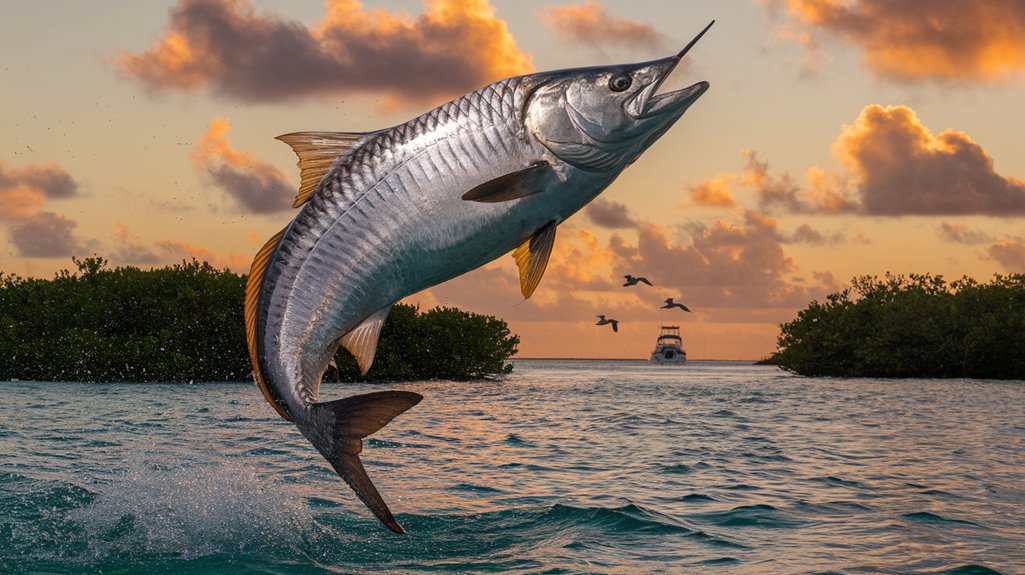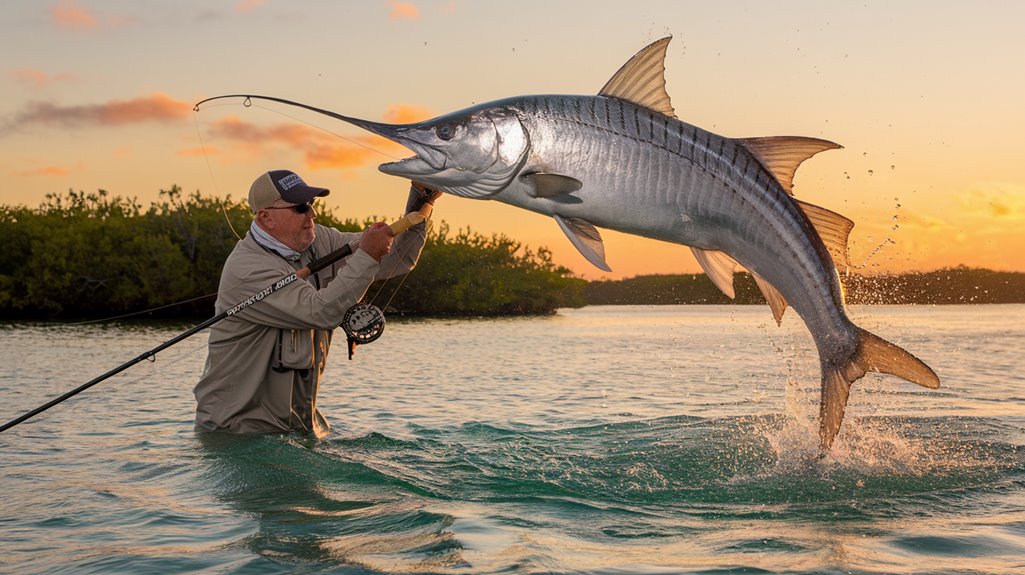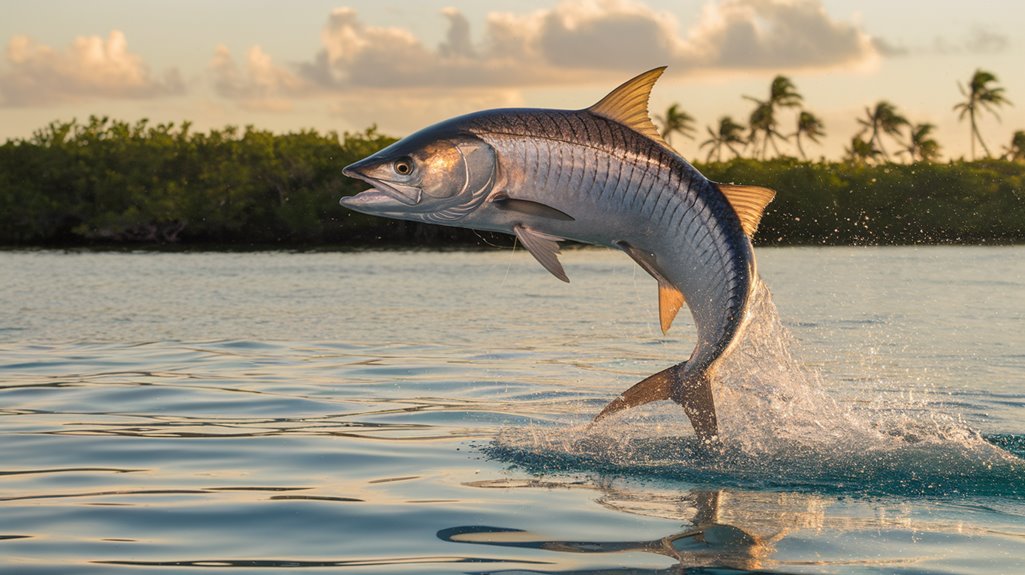Statistics show that over 50,000 tarpon migrate through Boca Grande Pass each spring, making it the world's premier tarpon fishing destination. You'll find these majestic "silver kings" prowling the waters from the Florida Keys to the Texas coastline, with each location offering distinct tactical advantages for your pursuit. Whether you're planning to fish the legendary pass or explore lesser-known hotspots, understanding where and when to target these magnificent gamefish will dramatically improve your success rate.
- Key Takeaways
- The Legendary Waters of Boca Grande Pass
- Tampa Bay's Premier Tarpon Territory
- The Florida Keys: Silver King Paradise
- Gulf Coast Gems: Texas to Louisiana
- Essential Gear and Techniques for Trophy Tarpon
- Peak Seasons and Migration Patterns
- Mastering Live Bait Strategies
- Conservation and Catch-Release Best Practices
- International Hotspots: From Belize to Cuba
- Advanced Tips for Successful Tarpon Photography
- Frequently Asked Questions
- Conclusion
Key Takeaways
- Boca Grande Pass in Florida hosts up to 10,000 adult tarpon during pre-spawn feeding, making it North America's premier destination.
- Tampa Bay's Egmont Pass offers trophy-sized tarpon exceeding 200 pounds from April through August during falling tides.
- The Florida Keys provide year-round tarpon fishing opportunities across shallow flats and deep channels, peaking April through September.
- Texas and Louisiana offer excellent tarpon fishing at Galveston Bay, Port O'Connor, Atchafalaya Basin, and Lake Pontchartrain.
- International hotspots include Belize's 200-mile coastline and Cuba's Jardines de la Reina, featuring diverse habitats and abundant tarpon.
The Legendary Waters of Boca Grande Pass
When it comes to premier tarpon fishing destinations in North America, Boca Grande Pass stands in a class of its own. During the pre-spawn feed from May through early July, you'll find up to 10,000 adult tarpon congregating in these productive waters, drawn by abundant food sources including pass crabs, threadfins, and squirrelfish.
You'll experience unparalleled fishing trips where 100 tarpon can be spotted rolling within casting distance. The pass's unique tidal currents create ideal conditions for drift fishing, though you'll need to maintain proper distance from other boats. Remember, tarpon over 40 inches must remain in the water, so master your quick capture and survival techniques. Focus on swift photography and proper revival methods to guarantee these magnificent fish return safely to their legendary waters.
Tampa Bay's Premier Tarpon Territory
You'll discover Tampa Bay's exceptional tarpon territory at key passes including Egmont Pass, Southwest Pass, and Passage Key Inlet, where 200-pound-plus fish surface annually. These prime locations shine brightest from April through August when migrating tarpon flood the bay's warm waters. The falling tides around new and full moons offer your best shot at hooking up, especially when you're drift fishing with pass crabs or jumbo shrimp in the current.
Prime Pass Locations
Tampa Bay's network of prime passes stands as a demonstration to world-class tarpon fishing, with legendary spots like Egmont Pass, Southwest Pass, and Passage Key Inlet consistently producing trophy-class fish exceeding 200 pounds.
You'll find Egmont Pass particularly productive, with its impressive 1.5-mile width and depths reaching 90 feet supporting a thriving tarpon population. To maximize your chances of successful catches, time your fishing during strong falling tides around new or full moons. When targeting these magnificent game fish, you'll want to stock up on live baits like pass crabs, squirrelfish, and jumbo shrimp. Remember to maintain proper fishing etiquette by keeping your distance from other boats and adjusting your motor speed appropriately during drift fishing sessions.
Seasonal Migration Patterns
Understanding seasonal migration patterns elevates your tarpon fishing success beyond the prime pass locations. You'll find Tampa Bay's most productive tarpon season runs from April through August, when migrating fish move through the area's deep waters, inlets, and channels. During this period, ideal fishing conditions align with falling tides around new and full moons.
- Target Egmont Pass for trophy-sized tarpon exceeding 200 pounds, taking advantage of the abundant food sources
- Employ drift fishing techniques to maintain proper distance from other vessels while utilizing tidal movements
- Focus your efforts on diverse habitats where seasonal migration routes intersect with natural bottlenecks
The combination of Tampa Bay's unique geography and seasonal migration patterns creates perfect conditions for consistently successful tarpon fishing, particularly when you time your trips with lunar phases.
The Florida Keys: Silver King Paradise

While many destinations boast excellent tarpon fishing, the Florida Keys stand as the ultimate paradise for pursuing the legendary "silver king." From April through September, these pristine waters teem with adult tarpon, drawing serious anglers to the region's diverse fishing grounds.
You'll find prime fishing opportunities across varied fishing environments, from shallow flats to deep channels between islands. Key West's waters prove particularly productive during slack tide periods. Whether you're targeting trophy-sized tarpon near tributaries or stalking them in the open Gulf, you'll discover success using baits like shrimp, crabs, mullets, and pinfish. For ideal results, partner with experienced guides who know these waters intimately. They'll help you navigate the Keys' complex ecosystem and maximize your chances of landing these magnificent gamefish.
Gulf Coast Gems: Texas to Louisiana
From the western shores of Texas to Louisiana's rich coastal marshes, the Gulf Coast offers exceptional tarpon fishing opportunities that rival Florida's famous grounds. You'll find prime locations like Galveston Bay and Port O'Connor along the Gulf Coast of Texas, where large schools gather from April through July. Louisiana's top tarpon fishing destinations include the crystal-clear coastal marshes, the mighty Atchafalaya Basin, and Lake Pontchartrain.
- Port O'Connor stands out as the best tarpon fishing spot in Texas, with productive jetty areas perfect for both fly fishing and spinning tackle
- The Atchafalaya Basin hosts some of Louisiana's largest tarpon, particularly during late spring and summer
- Lake Pontchartrain offers year-round action with smaller tarpon, making it ideal for beginners and experienced anglers alike
Essential Gear and Techniques for Trophy Tarpon

Your best shot at landing trophy tarpon starts with selecting the right tackle setup – an 8-foot heavy-action rod paired with a Penn 4/0 reel spooled with 80- to 100-pound braid and a 100-pound mono leader. When presenting live bait, you'll need to mount a 6-ounce weight above your leader using a heavy-duty swivel, allowing baits like pass crabs and jumbo shrimp to reach the ideal strike zone. Mastering high-speed casting techniques is critical, as you'll often need to make precise casts beyond 70 feet to effectively target these powerful gamefish in their feeding areas.
Choosing Your Tarpon Tackle
Successfully landing trophy tarpon requires precise tackle selection and proper rigging techniques. You'll need an 8-foot heavy-action conventional rod paired with a Penn 4/0 reel, spooled with 80- to 100-pound-test braid line. Attach a 100-pound test mono leader and a 6-ounce weight using a heavy-duty swivel to handle strong currents.
- Select live baits like pass crabs, squirrelfish, or jumbo shrimp, adjusting depth based on feeding patterns
- Time your fishing during strong falling tides around new or full moons, especially during spring tides
- Master quick release techniques – never boat tarpon over 40 inches, and guarantee proper handling for survival
Your tackle setup must withstand powerful runs while maintaining sensitivity to detect subtle strikes, making proper gear selection vital for landing these magnificent gamefish.
Mastering Live Bait Presentation
Proper live bait presentation makes the difference between a hook-up and a missed opportunity when pursuing trophy tarpon. You'll want to rig live baits like pass crabs, squirrelfish, or jumbo shrimp with a 6-ounce weight above your 100-pound mono leader. This setup keeps your bait in the feeding zone where tarpon are most active.
Time your fishing during strong falling tides around new or full moons for best results. When you drift fish, maintain proper distance from other boats and adjust your motor speed accordingly. Once you've hooked up, focus on quick capture and proper revival techniques. After de-hooking, guarantee the tarpon's survival by creating adequate water flow – either pump the fish or tow it until it's strong enough for release.
Peak Seasons and Migration Patterns
While tarpon can be found in various locations throughout the year, their most significant migration patterns occur from April through July across multiple prime fishing spots. You'll find the highest concentrations in Florida's Boca Grande Pass, where up to 10,000 adult tarpon gather for pre-spawn feeding. The tarpon migration extends through the Florida Keys and Miami's Biscayne Bay, offering exceptional fishing opportunities until September.
- Boca Grande Pass sees peak activity from April to July, with massive schools of migrating tarpon
- The Florida Keys maintain consistent tarpon action from April through September, ideal for anglers of all skill levels
- International destinations like Belize and Cuba's Jardines de la Reina offer unique opportunities, with Cuba known for aggressive juvenile tarpon under 30 pounds
Mastering Live Bait Strategies
When targeting tarpon in prime locations like Boca Grande Pass and Tampa Bay, you'll need to master the use of proven live baits including pass crabs, squirrelfish, and jumbo shrimp. Your bait selection should match the local forage and seasonal patterns, with particular attention to moon phases and tidal movements that influence feeding behavior. Proper rigging technique is essential – hook your live bait carefully to maintain its natural swimming action while ensuring it's positioned at the ideal depth where tarpon are actively feeding.
Natural Bait Selection Basics
The art of selecting natural bait for tarpon demands a strategic approach focused on three prime choices: pass crabs, squirrelfish, and jumbo shrimp. You'll need to pair your bait selection with proper rigging, using an 80- to 100-pound-test braid line and 100-pound mono leader for maximum strength against powerful strikes.
- Deploy a 6-ounce weight above your leader with a heavy-duty swivel to maintain ideal bait positioning
- Adjust your presentation depth throughout the day to match tarpon feeding patterns and tidal movements
- Maintain proper fishing protocols by respecting distance from other boats while deploying live bait
Your success rate will increase greatly when you match these natural baits to the local habitat conditions and maintain them in the strike zone where tarpon actively feed.
Rigging For Maximum Results
Success in live bait tarpon fishing hinges on proper rigging techniques and gear selection. You'll want to pair a heavy-action rod (8-foot conventional) with a Penn 4/0 reel, spooled with 80- to 100-pound braided line and a 100-pound mono leader. For maximum results, secure a 6-ounce weight above your leader using a heavy-duty swivel to effectively present live baits like pass crabs, squirrelfish, or jumbo shrimp.
Monitor tarpon feeding patterns and adjust your bait's depth accordingly, as these fish move through the water column based on tides and time of day. Time your fishing during strong falling tides, especially around new or full moons. Before heading out, check local fishing regulations, as live bait restrictions may vary by season and location to support conservation efforts.
Conservation and Catch-Release Best Practices
Maintaining tarpon populations for future generations requires strict adherence to catch-and-release protocols that prioritize fish survival. You'll need to keep fish over 40 inches in the water while handling them, using wet hands or gloves to minimize stress. For ideal results, time your fishing during strong falling tides around new or full moons, avoiding slack water periods.
- De-hook and photograph your catch at boatside, guaranteeing proper water flow over the gills through pumping or towing techniques
- Practice quick capture and release methods, limiting air exposure to protect the tarpon's health
- Follow local conservation regulations and proper handling techniques to maximize survival rates and preserve critical habitats
Remember: Best practices aren't just guidelines – they're fundamental steps that guarantee tarpon populations remain healthy for future anglers.
International Hotspots: From Belize to Cuba
While many anglers focus on domestic waters, international destinations like Belize and Cuba's Jardines de la Reina offer world-class tarpon fishing opportunities in pristine, less-pressured environments.
Belize's 200-mile coastline features diverse habitats that support both resident and migratory tarpon, with peak fishing from April to September when you'll find specimens ranging from 30 to 100 pounds. In contrast, Cuba's Jardines de la Reina presents a unique mix of flats, channels, and mangrove islands where aggressive juvenile tarpon under 30 pounds dominate the action. You'll also encounter adults up to 80 pounds in these pristine waters. While fishing Cuba's locations requires careful planning due to travel restrictions, the abundant forage and exceptional conditions make it worth the extra effort, particularly during migration periods.
Advanced Tips for Successful Tarpon Photography
To capture stunning tarpon photography, positioning yourself at eye level with these magnificent game fish creates the most dramatic and impactful shots. Standing in chest-deep water provides the perfect vantage point while letting you maneuver quickly to minimize stress on the fish before release. Clear water conditions are essential for peak image quality, and you'll want to time your shoots during early morning or late afternoon for the best natural lighting.
- Use a waterproof camera or housing to safely experiment with creative angles while standing in the water
- Focus on quick, efficient shots to reduce handling time and guarantee the tarpon's survival
- Scout locations in advance to find spots with crystal-clear water and ideal lighting conditions
These techniques will help you document your catches while preserving the environment and respecting these remarkable fish.
Frequently Asked Questions
Where Is the Best Tarpon Fishing in the US?
You'll find America's best tarpon fishing at Boca Grande Pass, Florida, where up to 10,000 adult tarpon gather during peak season. Tampa Bay, the Florida Keys, and Galveston Bay follow closely behind.
Where Is the Best Place to Fish for Tarpon in the World?
You'll find the world's best tarpon fishing at Boca Grande Pass, Florida, with up to 10,000 adult tarpon during peak season. Cuba's Jardines de la Reina offers pristine waters for targeting aggressive juveniles.
Where Is the Tarpon Capital of the World?
Like a silver-scaled treasure chest, Islamorada, Florida, reigns as the world's tarpon capital. You'll find peak fishing from April to July when massive migrations converge in the area's diverse flats and channels.
How Old Is a 100 Pound Tarpon?
You'll typically find a 100-pound tarpon to be between 10 and 15 years old, though this can vary based on gender, habitat conditions, and food availability in their marine environment.
Conclusion
When you're chasing the silver king, remember that these magnificent fish can reach speeds of 35 miles per hour and leap up to 10 feet high. You'll find success at any of these prime locations by applying proper techniques, respecting conservation practices, and staying patient. Whether you're targeting Florida's legendary passes or venturing to international waters, you've got all the tools needed to land your trophy tarpon.

